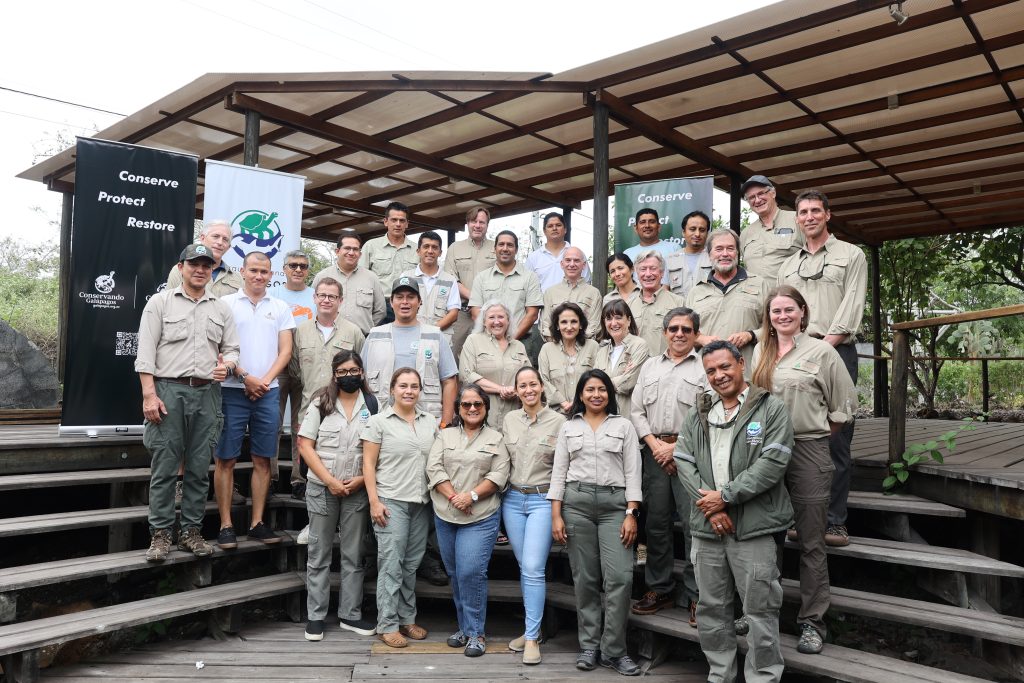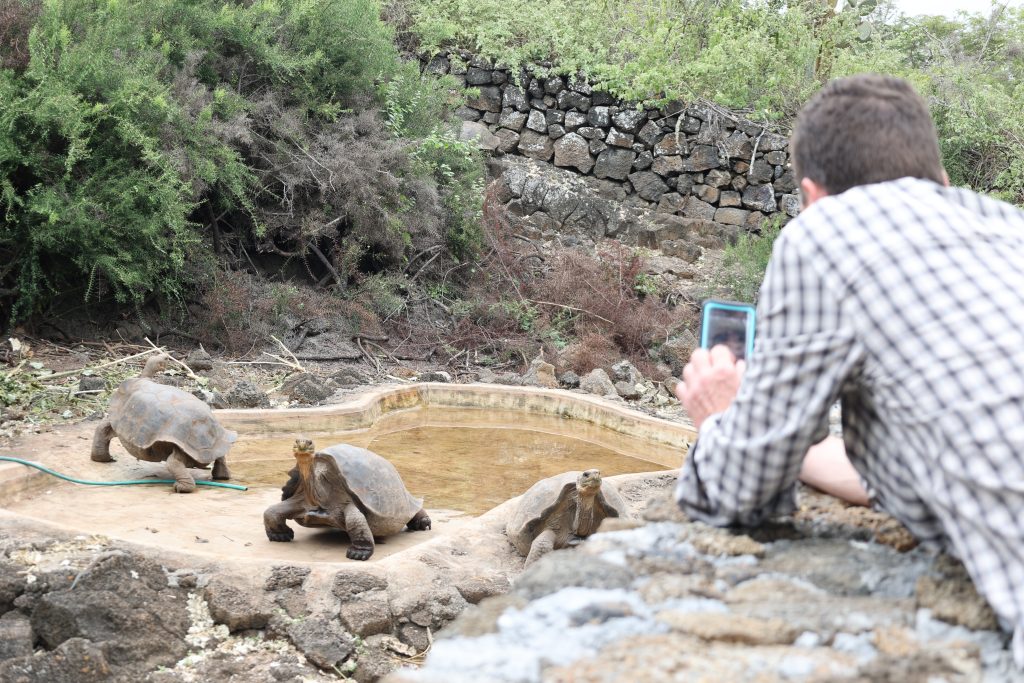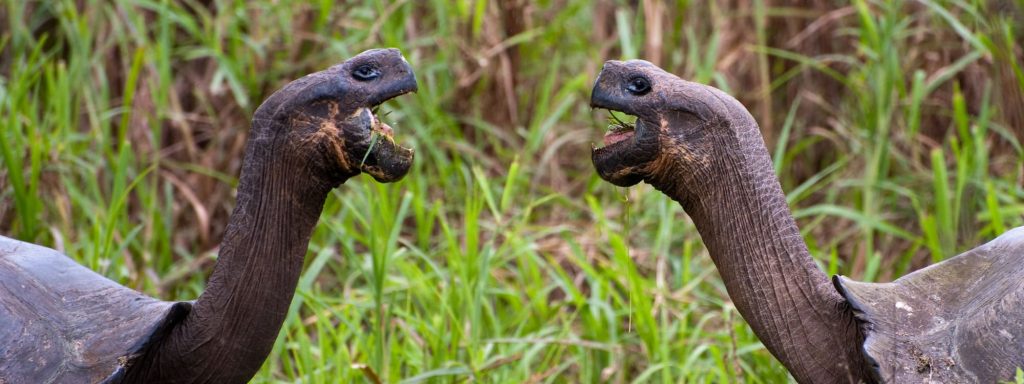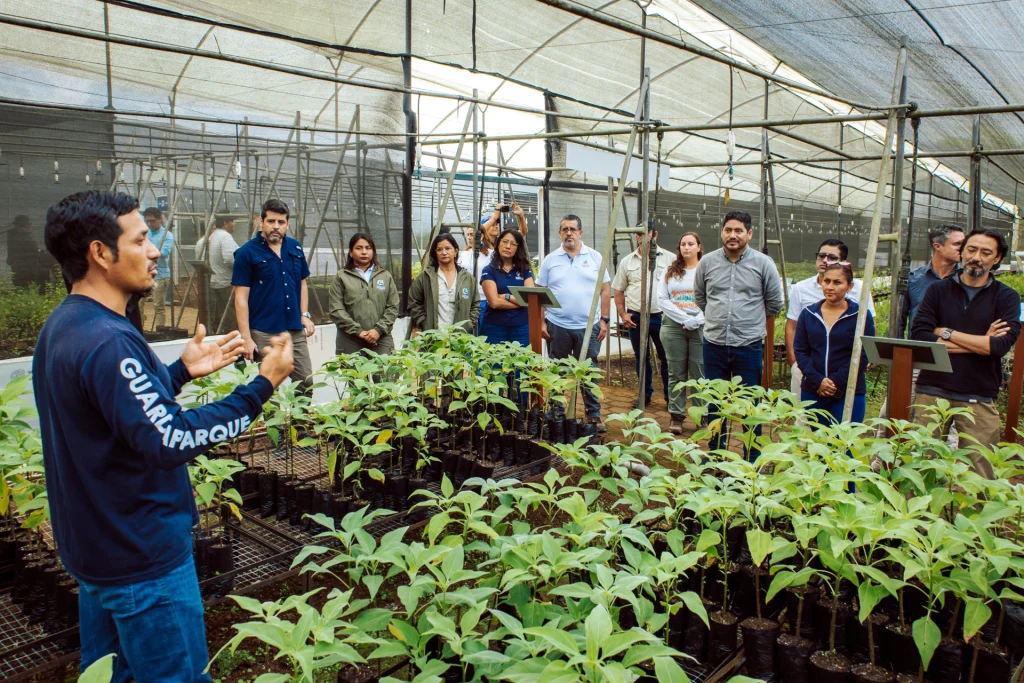Galápagos Conservancy Board of Directors Supervises Projects Implemented in The Archipelago
// Versión en español abajo //

The members of the Board of Directors of Galápagos Conservancy together with senior staff visited the Galápagos Islands in June to review the conservation actions financed and executed by the organization with the ultimate goal of ensuring the long-term protection of the archipelago’s ecosystems in harmony with the community of residents.
Their first meeting was held with the Galápagos National Park Directorate (GNPD) to learn about the progress, achievements, and future needs of the projects implemented in coordination with this institution that is responsible for the management of the Galápagos marine and terrestrial ecosystems. The Director of the National Park, M.Sc. Danny Rueda, emphasized the contribution of Galápagos Conservancy in the restoration of threatened species, which contributes directly and inexorably to the restoration of the ecosystems where these species live.
The delegation also visited the Giant Tortoise Breeding Centers where Galápagos Conservancy and GNPD staff care for 977 tortoises on Isabela Island (64 adults and 913 juveniles) and 1,246 individuals (74 adults and 1,172 juveniles) on Santa Cruz Island. In these Centers, young tortoises are raised and cared for until they are approximately 5 or 6 years old, large enough to avoid predation, and physically ready to be repatriated. These Centers have been a vital management component to restore Giant Tortoise populations and a core part of “Iniciativa Galápagos” – a partnership between Galapagos Conservancy and GNPD to rewild Galápagos.
Alongside rewilding native flora and fauna, the fight to control and eradicate invasive species is another of the priorities of Galápagos Conservancy. For this reason, the members of the Board of Directors also visited the facilities of the Agency for the Regulation and Control of Biosafety and Quarantine for Galápagos (ABG). ABG’s Executive Director, Dr. Marilyn Cruz, gave a tour of the institution’s facilities and highlighted the importance of Galápagos Conservancy joining the challenge of combating aggressive nonnative species. The Board participated in the nighttime collection of the non-native invasive African Snails (Lissachatina fulica), included on the list of the 100 most invasive exotic species in the world by the International Union for Conservation of Nature.
The Board of Directors also visited the Galápagos National Educational Unit where they planted native and endemic trees and ratified the continuity of the organization’s support for strengthening educational quality in the islands. Lic. Tito Gavilanes, the director of the educational institution, thanked Galápagos Conservancy for more than six years of continuous support in strengthening educator capacities through Teacher Training Institutes.
Their first meeting was held with the Galápagos National Park Directorate (DPNG) to learn about the progress, achievements, and future needs of the projects implemented in coordination with this institution that responsible for the management of the Galápagos marine and terrestrial ecosystems. The Director of the National Park, M.Sc. Danny Rueda emphasized the contribution of Galápagos Conservancy in the restoration of threatened species, which contributes directly and scrupulously to the restoration of the ecosystems where these species live.
The delegation also visited the GNPD Giant Tortoise Breeding Centers where 977 tortoises are kept on Isabela Island (64 adults and 913 juveniles) and 1,246 individuals (74 adults and 1,172 juveniles) on Santa Cruz Island. In these centers, juvenile tortoises are raised and cared for until they are approximately 5 or 6 years old and physically ready to be repatriated. Since their creation in 1965, these Centers have been a vital management component to restore Giant Tortoise populations.
On the other hand, the fight against the control and eradication of invasive species is another of the priorities of the Galápagos Conservancy. For this reason, the members of the Board of Directors also visited the facilities of the Agency for the Regulation and Control of Biosafety and Quarantine for Galápagos (ABG), the executive director, Dr. Marilyn Cruz, gave a tour of the institution’s facilities and highlighted the importance of Galápagos Conservancy joining to combat the challenge of controlling and fighting invasive species. They participated in the nocturnal collection of the African Snail (Lissachatina fulica), included in the list of the 100 most invasive exotic species in the world by the IUCN (International Union for Conservation of Nature).
Another outstanding activity where the members of the Board of Directors participated was the visit to the Galápagos National Educational Unit. During this activity, they planted native and endemic trees and ratified the continuity of the Organization’s support for strengthening educational quality in the islands. The Director of the educational institution, Lic. Tito Gavilanes, thanked the commitment of Galápagos Conservancy for more than 5 years of continuous support, strengthening teaching capacities through the Training Institutes, and addressing sustainability issues that also respond to problems and needs of the educational sector of Galápagos.

To close their visit, the Board of Directors participated in the first conservation action fair and got to know some of the sustainability projects financed by Galápagos Conservancy, recognizing that the empowerment of the community through conservation can create positive and sustainable change for people and island ecosystems alike.
The Board of Directors all emphasized that they are proud of the work of the Galápagos Conservancy and impressed with the staff implementation of local conservation action in partnership with members of the National Environmental Authority. The Board of Directors also reiterated Galápagos Conservancy’s commitment to continue working to save endangered species, rewild Galápagos, and promote sustainable communities.
Junta Directiva de Galápagos Conservancy supervisa proyectos implementados en el Archipiélago
Los miembros de la Junta Directiva de Galápagos Conservancy visitaron las islas Galápagos en el mes de junio para supervisar las acciones de conservación financiadas y ejecutadas por la organización con el fin último de asegurar la protección a largo plazo de los ecosistemas del archipiélago y la armonía con la comunidad humana residente.
Su primera reunión la mantuvieron con la Dirección del Parque Nacional Galápagos (DPNG) para conocer de cerca los avances, logros y futuras necesidades de los proyectos implementados en coordinación con esta institución, responsable del manejo de los ecosistemas marinos y terrestres de Galápagos. El Director del PNG, M.Sc. Danny Rueda, enfatizó el aporte de Galápagos Conservancy en la restauración de especies amenazadas, que contribuye directa e integralmente a la restauración de los ecosistemas donde estas especies habitan.
La comitiva también visitó los Centros de reproducción y crianza de tortugas gigantes de la DPNG donde se mantienen 977 tortugas en la isla Isabela (64 adultas y 913 juveniles) y 1246 individuos, (74 adultas y 1172 juveniles) en la isla Santa Cruz. En estos centros se cría y cuida tortugas juveniles aproximadamente hasta los 5 o 6 años de edad, hasta que están físicamente preparadas para ser repatriadas. Desde su creación en 1965, estos Centros han sido un componente vital de manejo para la restauración de las poblaciones de tortugas gigantes.
Por otro lado, la lucha contra el control y erradicación de especies invasoras es otra de las prioridades de Galápagos Conservancy, por eso los miembros de su Junta Directiva también visitaron las instalaciones de la Agencia de Regulación y Control de la Bioseguridad y Cuarentena para Galápagos (ABG), su directora ejecutiva, la Dra. Marilyn Cruz, brindó un recorrido por las instalaciones de la institución y destacó la importancia de que Galápagos Conservancy se haya sumado al desafío de controlar y luchar contra las especies invasoras. De manera práctica, participaron en la recolección nocturna del Caracol africano (Lissachatina fulica), incluido en la lista de las 100 especies exóticas más invasoras del mundo de la UICN (Unión Internacional para la Conservación de la Naturaleza).
Otra de las actividades destacadas de los miembros de la Junta Directiva fue la visita a la Unidad Educativa Nacional Galápagos, donde participaron en la siembra de árboles nativos y endémicos, y además ratificaron la continuidad del apoyo de la Organización al fortalecimiento de la calidad educativa en las islas. El Director de la institución educativa, Lic. Tito Gavilanes, agradeció el compromiso de Galápagos Conservancy por los más de 5 años de continuo apoyo fortaleciendo las capacidades docentes a través de los Institutos de Capacitación, abordando temas de sostenibilidad que responden además a problemas y necesidades del sector educativo de Galápagos.



